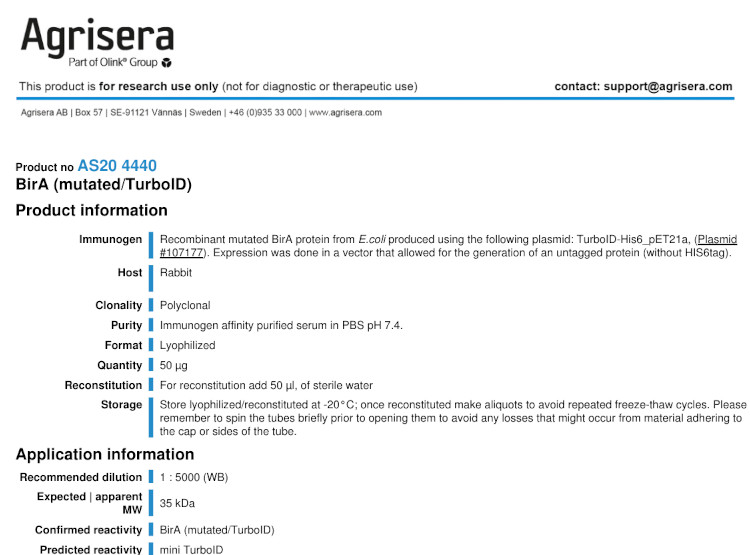| Protein-protein interactions in crop plants can be studied using transient TurboID-based proximity labeling. In the recent publication "Protocol to identify protein-protein interaction networks in Solanum tuberosum using transient TurboID-based proximity labeling" from the Laboratory of Plant Breeding, Wageningen University & Research, The Netherlands, authors Li Shi et al. described the methodology of transient expression of constructs of a protein under investigation, fused to TurboID, and the identification of protein-protein interactions in potato leaves. The publication describes a detailed protocol for preparation of plant material and transgene desing, as well as protein identification, using Agrisera's anti-TurboID antibody (AS20 4440). The authors also discuss limitations of the protocol, and provide suggestions on how to adress them. Steps of the protocol include:
|  |
Latest
Interview with Prof. Martha Ludwig2025-03-19 Agrisera supports Annual Congress of Young Researchers (ACYR 2025)
2025-03-14 Interview with Prof. Rebecca Roston
2025-03-05 Agrisera Western blot workshop part I with Yao-Hong Biotechnology for researchers in Taiwan
2025-02-28 Interview with Prof. Junpeng Zhan
2025-02-19 Agrisera at 38th Molecular Biology of Plants conference
2025-02-13 Agrisera's new distributor in USA
2025-02-06 Interview with Prof. Sabeeha Merchant
2025-02-05 Agrisera supported 34th Western Photosynthesis Conference
2025-01-27 Agrisera at UCMR Day 2025
2025-01-23
Archive
- April - 2025
- March - 2025
- February - 2025
- January - 2025
- December - 2024
- November - 2024
- October - 2024
- September - 2024
- August - 2024
- July - 2024
- June - 2024
- May - 2024
- April - 2024
- March - 2024
- February - 2024
- January - 2024
- December - 2023
- November - 2023
- October - 2023
- September - 2023
- August - 2023
- July - 2023
- June - 2023
- May - 2023
- April - 2023
- March - 2023
- February - 2023
- January - 2023
- December - 2022
- November - 2022
- October - 2022
- September - 2022
- August - 2022
- July - 2022
- June - 2022
- May - 2022
- April - 2022
- March - 2022
- February - 2022
- January - 2022
- December - 2021
- November - 2021
- October - 2021
- September - 2021
- August - 2021
- July - 2021
- June - 2021
- May - 2021
- April - 2021
- March - 2021
- February - 2021
- January - 2021
- December - 2020
- November - 2020
- October - 2020
- September - 2020
- August - 2020
- July - 2020
- June - 2020
- May - 2020
- April - 2020
- March - 2020
- February - 2020
- January - 2020
- December - 2019
- November - 2019
- October - 2019
- September - 2019
- August - 2019
- July - 2019
- June - 2019
- May - 2019
- April - 2019
- March - 2019
- February - 2019
- January - 2019
- December - 2018
- November - 2018
- October - 2018
- September - 2018
- August - 2018
- July - 2018
- June - 2018
- May - 2018
- April - 2018
- March - 2018
- February - 2018
- January - 2018
- December - 2017
- November - 2017
- October - 2017
- September - 2017
- August - 2017
- July - 2017
- June - 2017
- April - 2017
- March - 2017
- February - 2017
- December - 2016
- November - 2016
- October - 2016
- September - 2016
- August - 2016
- July - 2016
- June - 2016
- May - 2016
- April - 2016
- March - 2016
- February - 2016
- January - 2016
- December - 2015
- November - 2015
- October - 2015
- September - 2015
- August - 2015
- July - 2015
- June - 2015
- May - 2015
- March - 2015
- February - 2015
- January - 2015
- December - 2014
- November - 2014
- October - 2014
- September - 2014
- August - 2014
- July - 2014
- June - 2014
- May - 2014
- April - 2014
- March - 2014
- February - 2014
- January - 2014
- December - 2013
- November - 2013
- September - 2013
- August - 2013
- July - 2013
- June - 2013
- May - 2013
- April - 2013
- February - 2013
- January - 2013
- December - 2012
- October - 2012
- September - 2012
- August - 2012
- July - 2012
- June - 2012
- May - 2012
- April - 2012
- March - 2012
- December - 2011
- November - 2011
- September - 2011
- August - 2011
- July - 2011
- April - 2011
- January - 2011
- December - 2010
- October - 2010
- September - 2010
- August - 2010
- July - 2010
- March - 2010
- January - 2010
- December - 2009
- November - 2009
- September - 2009
- July - 2009
- June - 2009
- May - 2009
- March - 2009
- January - 2009
- December - 2008
